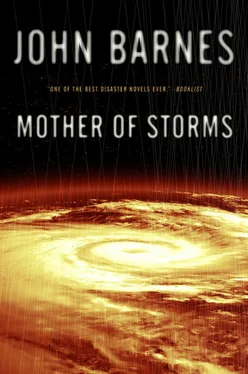Carla Tynan knows they are there only when they yank the jack out of her skull; she has time to shout hey ! before they break the connection. They empty a machine pistol into her before she even gets her hands positioned to cover her nakedness.
Brittany Lynn Hardshaw would like to grieve but there’s no time. Secret Service people are hustling her down one of the safety tunnels to the secure chambers. Harris is gone… and the others, whom she was getting to know and like—
“It was the Siberians, almost for sure,” Hardshaw says aloud. “Probably Abdulkashim’s old faction, waiting to hit us until the worst was about to descend. Did you get one for questioning?”
The Secret Serviceman who was guarding Harris Diem shakes his head. “It was a totally professional hit. His house had been surrounded for days by two different teams, a group of six commandos and a single agent. The commandos pulled back a block and it looked like they were grouping for an attack, especially since they left electronic monitors in place. We had the single guy pegged as the scout. Naturally we followed the team—but that guy was Superman. He nailed the house electronics, got in there, shot Mr. Diem, all in maybe two minutes. Did it with a Self Defender, of all the corny things—but of course that gave the commando team a signal. They came in throwing incendiaries, and… well, the house was totalled. It’s still burning. And all of them died in the fighting. We’re not even sure which body is Mr. Diem and which is the solo agent—they were about the same size physically.”
Hardshaw nods. “I wish we’d had the chance, but I don’t suppose that we can have much doubt. The idea was to put us in chaos just before the superstorm, and they’re listening in all the time. Get me a playback on the transmission.” She strides into the saferoom, the room the White House has had since the Flash, and sits at her desk. They set up a video screen and the signal begins to play. One of the Secret Service agents whispers that they have no confirmed attack aimed in her direction.
She hears Diogenes Callare and Carla Tynan explaining it to her again. God, it’s hard to believe that none of their bodies are cold yet.
At the end of the tape, she says, “Well, they’re right. No public announcement. But I think we’d better get ready to run… no, scratch that. I’ve got faith in Carla Tynan, anyway, and if she said it was going to happen that fast, it was. Get me to Charleston and start the Federal evacuation as quickly as you can.”
When the eye forms in the Bay of Campeche, there is more than adequate energy; the eye wall swells outward, and windspeeds rise; as they approach Mach 1 they rise more slowly, but they don’t stop rising.
Just after dark, there’s a brief time when the sea chums and thunders, waves a hundred meters high whipping up and crashing down; then the airflow abruptly becomes smooth and layered—the eyewall has passed into the supersonic realm.
By that time the center of the eye is at 92W 22N, well out into the Gulf of Mexico, and the eye is already 400 km in diameter. Storm surges are already lashing Veracruz and are pouring upward toward the American Gulf Coast.
Carla’s model missed one detail, but only one. Just as she predicted, within twenty minutes the hurricane has swollen until there are Beaufort 12 or higher force winds across an area 1,600 km in diameter, as if a great drain plug had been pulled at the center of the Gulf. The eye has fallen to 530 mb in pressure, and the eye itself is rapidly swelling, the winds gaining force.
Nonetheless, Carla missed the detail that in addition to its tsunami-sized storm surges, a supersonic storm is large enough to lift significant quantities of warm water. The better mixing of water and air, in turn, means the air gets warmer and there’s greater efficiency in the storm, converting the heat of the sea to wind. It has more energy—and a lot more water.
When Jesse gets the word that Di has been murdered, he sits down and cries for an hour. Mary Ann isn’t sure what to do. She’s lost some acquaintances in XV, and you’re supposed to overreact to that—she really admires hell out of Surface O’Malley for not going along with that policy. But this is just a kid who is crying for his big brother. What do you say? “Cheer up”?
She finally settles on, “I’m so terribly sorry.”
He hangs on to her as if he were drowning, and she holds his head and strokes his hair. She thinks about how the world slips away, how she’ll never meet Di now (and she had looked forward to it), how Jesse will never quite be the same because pointless evil has gotten into his world.
All across North America and Europe, people who should be evacuating sit down to grieve with Synthi Venture.
Death comes quickly for millions as Clem 900 is born. Within hours storm surges are large enough to rage right across Florida. Those who couldn’t or wouldn’t evacuate before now are drowned by the waves, tens of meters high, that pour over the peninsula one after another; the mangroves that have held the land give way, concrete crumbles, steel bends and breaks, and the surface of Florida is washed off into the Atlantic to thunder down the continental slope in a great avalanche. More and more follows; there will be little land left by morning.
Winds reach speeds of 100 mph as far north as Memphis, and cities and forests are flattened.
The rotary current produced by the storm begins to scour the Gulf out on all sides, chewing off Plaquemines Parish from Louisiana, reopening Lake Pontchartrain to the sea, and eating away at the whole Gulf Coast from Brownsville to Panama City. When next the sun comes out, it will be on a much wider Gulf—and one with much more open jaws.
The Caribbean islands, at the center, are drowned to their highest mountain peaks, battered, eroded, scoured into new shapes. They will become wildernesses of rubble, sand, rock, and packed debris—but only after the storm stops. Right now they are places where the water and wind foam furiously at the obstacles.
And yet all this pales beside the effects of the new storm’s outflow jets. Sucking up seawater like a giant vacuum cleaner, mixing far more efficiently and thus using more of the available energy, the great hurricane dumps more than a thousand tons of water per square acre—the equivalent of ten inches of rain—all over the eastern third of the United States in the nine hours before the storm abruptly veers to roar across the Atlantic, gaining energy before it mauls its way into Europe, still dropping saltwater three days later as far inland as Kazakhstan.
The Mississippi is briefly as wide as Lake Erie; the James River carries all of Richmond out to sea, and running water rises seventy feet on the Flash-scarred stub of the Washington Monument.
In Georgetown, the still-smoldering remains of Harris Diem’s home are picked up and dragged away by the current. The burned remains of Randy Householder had not even been pulled from the rubble, and what is left of him mixes in and is swept out to the Atlantic, along with all the wedges of the raped and murdered girls.
In all his dark dreams, Harris Diem never imagined that it was possible that no one would ever know. But fourteen years after her miserable death, it is as if there never were a Kimbie Dee Householder.
Karen always kind of hates herself for thinking it, but here she goes again… she wonders what Mary Ann would do now. It’s funny how life diverges… Karen’s hair was too dark to take the needle well, and her hips were just a little too wide, so she wasn’t called back for the Passionet auditions.
And the strange result is that while Synthi Venture is down in warm, safe Mexico with a great-looking young kid, Karen Mary Ann finds herself sitting in the Dance Channel Tower—the tallest building in the United States, so big that Herald Square is its central courtyard—and looking down on the boiling anthill of Manhattan.
Читать дальше












